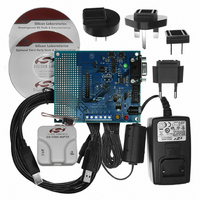C8051F330DK Silicon Laboratories Inc, C8051F330DK Datasheet - Page 91

C8051F330DK
Manufacturer Part Number
C8051F330DK
Description
DEV KIT FOR C8051F330/F331
Manufacturer
Silicon Laboratories Inc
Type
MCUr
Specifications of C8051F330DK
Contents
Evaluation Board, Power Supply, USB Cables, Adapter and Documentation
Processor To Be Evaluated
C8051F33x
Interface Type
RS-232
Operating Supply Voltage
7 V to 15 V
Silicon Manufacturer
Silicon Labs
Core Architecture
8051
Silicon Core Number
C8051F330
Silicon Family Name
C8051F33x
Lead Free Status / RoHS Status
Contains lead / RoHS non-compliant
For Use With/related Products
Silicon Laboratories C8051F330, C8051F331
Lead Free Status / Rohs Status
Lead free / RoHS Compliant
Other names
336-1264
- Current page: 91 of 210
- Download datasheet (2Mb)
C8051F330/1/2/3/4/5
9.4.
The CIP-51 core has two software programmable power management modes: Idle and Stop. Idle mode
halts the CPU while leaving the peripherals and clocks active. In Stop mode, the CPU is halted, all inter-
rupts and timers (except the Missing Clock Detector) are inactive, and the internal oscillator is stopped
(analog peripherals remain in their selected states; the external oscillator is not effected). Since clocks are
running in Idle mode, power consumption is dependent upon the system clock frequency and the number
of peripherals left in active mode before entering Idle. Stop mode consumes the least power. SFR Defini-
tion 9.12 describes the Power Control Register (PCON) used to control the CIP-51's power management
modes.
Although the CIP-51 has Idle and Stop modes built in (as with any standard 8051 architecture), power
management of the entire MCU is better accomplished by enabling/disabling individual peripherals as
needed. Each analog peripheral can be disabled when not in use and placed in low power mode. Digital
peripherals, such as timers or serial buses, draw little power when they are not in use. Turning off the oscil-
lators lowers power consumption considerably; however a reset is required to restart the MCU.
9.4.1. Idle Mode
Setting the Idle Mode Select bit (PCON.0) causes the CIP-51 to halt the CPU and enter Idle mode as soon
as the instruction that sets the bit completes execution. All internal registers and memory maintain their
original data. All analog and digital peripherals can remain active during Idle mode.
Idle mode is terminated when an enabled interrupt is asserted or a reset occurs. The assertion of an
enabled interrupt will cause the Idle Mode Selection bit (PCON.0) to be cleared and the CPU to resume
operation. The pending interrupt will be serviced and the next instruction to be executed after the return
from interrupt (RETI) will be the instruction immediately following the one that set the Idle Mode Select bit.
If Idle mode is terminated by an internal or external reset, the CIP-51 performs a normal reset sequence
and begins program execution at address 0x0000.
Note: If the instruction following the write of the IDLE bit is a single-byte instruction and an interrupt occurs
during the execution phase of the instruction that sets the IDLE bit, the CPU may not wake from Idle mode
when a future interrupt occurs. Therefore, instructions that set the IDLE bit should be followed by an
instruction that has two or more opcode bytes, for example:
// in ‘C’:
PCON |= 0x01;
PCON = PCON;
; in assembly:
ORL PCON, #01h
MOV PCON, PCON
If enabled, the Watchdog Timer (WDT) will eventually cause an internal watchdog reset and thereby termi-
nate the Idle mode. This feature protects the system from an unintended permanent shutdown in the event
of an inadvertent write to the PCON register. If this behavior is not desired, the WDT may be disabled by
software prior to entering the Idle mode if the WDT was initially configured to allow this operation. This pro-
vides the opportunity for additional power savings, allowing the system to remain in the Idle mode indefi-
nitely, waiting for an external stimulus to wake up the system. Refer to
Timer Reset” on page 100
94
Power Management Modes
for more information on the use and configuration of the WDT.
// set IDLE bit
// ... followed by a 3-cycle dummy instruction
; set IDLE bit
; ... followed by a 3-cycle dummy instruction
Rev. 1.7
Section “10.6. PCA Watchdog
Related parts for C8051F330DK
Image
Part Number
Description
Manufacturer
Datasheet
Request
R
Part Number:
Description:
SMD/C°/SINGLE-ENDED OUTPUT SILICON OSCILLATOR
Manufacturer:
Silicon Laboratories Inc
Part Number:
Description:
Manufacturer:
Silicon Laboratories Inc
Datasheet:
Part Number:
Description:
N/A N/A/SI4010 AES KEYFOB DEMO WITH LCD RX
Manufacturer:
Silicon Laboratories Inc
Datasheet:
Part Number:
Description:
N/A N/A/SI4010 SIMPLIFIED KEY FOB DEMO WITH LED RX
Manufacturer:
Silicon Laboratories Inc
Datasheet:
Part Number:
Description:
N/A/-40 TO 85 OC/EZLINK MODULE; F930/4432 HIGH BAND (REV E/B1)
Manufacturer:
Silicon Laboratories Inc
Part Number:
Description:
EZLink Module; F930/4432 Low Band (rev e/B1)
Manufacturer:
Silicon Laboratories Inc
Part Number:
Description:
I°/4460 10 DBM RADIO TEST CARD 434 MHZ
Manufacturer:
Silicon Laboratories Inc
Part Number:
Description:
I°/4461 14 DBM RADIO TEST CARD 868 MHZ
Manufacturer:
Silicon Laboratories Inc
Part Number:
Description:
I°/4463 20 DBM RFSWITCH RADIO TEST CARD 460 MHZ
Manufacturer:
Silicon Laboratories Inc
Part Number:
Description:
I°/4463 20 DBM RADIO TEST CARD 868 MHZ
Manufacturer:
Silicon Laboratories Inc
Part Number:
Description:
I°/4463 27 DBM RADIO TEST CARD 868 MHZ
Manufacturer:
Silicon Laboratories Inc
Part Number:
Description:
I°/4463 SKYWORKS 30 DBM RADIO TEST CARD 915 MHZ
Manufacturer:
Silicon Laboratories Inc
Part Number:
Description:
N/A N/A/-40 TO 85 OC/4463 RFMD 30 DBM RADIO TEST CARD 915 MHZ
Manufacturer:
Silicon Laboratories Inc
Part Number:
Description:
I°/4463 20 DBM RADIO TEST CARD 169 MHZ
Manufacturer:
Silicon Laboratories Inc










